Introduction
As humans, we have achieved remarkable feats in aviation technology, enabling us to traverse the skies and explore the far reaches of the Earth. From bustling airports to remote airstrips, planes have become an integral part of our global transportation network. However, there are places on our planet where the wings of aircraft are prohibited from soaring due to unique challenges posed by geography, environment, or political considerations. In this blog, we’ll embark on a virtual journey to some of the most intriguing places where planes can’t fly.
1. Salar de Uyuni, Bolivia
Nestled in the Andes mountains of southwestern Bolivia, the Salar de Uyuni is the world’s largest salt flat, spanning over 10,000 square kilometers. While its vast expanse might seem like a perfect landing strip, the salt crust is often covered in water, making it a treacherous surface for aircraft. Additionally, the thin air at high altitudes further complicates flying in this region. Nonetheless, the Salar de UyunI remains a breathtaking destination for travelers seeking stunning vistas and surreal landscapes.
2. Mount Everest, Nepal
The highest point on Earth, Mount Everest, is a dream destination for mountaineers and adventurers. However, this towering peak presents insurmountable challenges for aviation due to the extreme altitudes, unpredictable weather, and powerful winds. Helicopters can fly near its base camp for rescue missions, but attempting to land on the summit is a feat reserved for a select group of elite climbers.
3. Machu Picchu, Peru
Perched on a mountain ridge high in the Andes, the ancient Incan city of Machu Picchu is a UNESCO World Heritage Site and one of the New Seven Wonders of the World. While there are no airports nearby due to the rugged terrain, the Peruvian government restricts the use of helicopters to preserve the site’s cultural and natural integrity. Visitors must access Machu Picchu through a combination of hiking and train journeys, adding to the allure of this historic treasure.
4. Vatican City
The world’s smallest independent state, Vatican City, is home to iconic landmarks like St. Peter’s Basilica and the Sistine Chapel. Despite its compact size, Vatican City has no airport due to limited space and the proximity of residential and historic buildings. Pilots flying over this enclave must adhere to strict no-fly zones to ensure the safety and privacy of its residents and visitors.
5. Antarctica
The frozen continent of Antarctica presents some of the most challenging flying conditions on the planet. Extreme cold, harsh winds, and unpredictable weather make it a dangerous environment for aircraft. While research stations are accessible by air, the lack of infrastructure and the need for specialized equipment make aviation in Antarctica a complex endeavor.
6. North Sentinel Island, Andaman and Nicobar Islands, India
Tucked away in the Bay of Bengal, North Sentinel Island is home to one of the last remaining uncontacted tribes in the world. The Sentinelese people have consistently shown hostility towards outsiders, making it nearly impossible for planes or helicopters to approach the island safely. To protect the tribe’s isolation and vulnerability to outside diseases, the Indian government enforces a strict no-fly zone and maintains a buffer around the island.
7. Aletsch Glacier, Switzerland
The Aletsch Glacier, the largest glacier in the Alps, is a stunning natural wonder. However, its uneven and constantly shifting ice surface, along with deep crevasses, makes it a perilous location for aircraft to land. The glacier’s fragile ecosystem also necessitates strict environmental protection measures, further restricting aerial access.
8. Area 51, Nevada, USA
Area 51, a highly secretive military installation in the Nevada desert, has long been the subject of conspiracy theories and speculation about extraterrestrial activity. While the specifics of what transpires within its boundaries remain classified, the airspace over Area 51 is heavily restricted. Unauthorized aircraft entering the airspace are swiftly intercepted by military aircraft, making it a no-fly zone with an air of mystery.
9. The Mariana Trench, Pacific Ocean
While not a physical place on land, the Mariana Trench, the deepest point on Earth’s seabed, presents an extreme challenge for aviation – or any form of human exploration, for that matter. With depths exceeding 36,000 feet (10,994 meters), the trench is a realm of crushing pressure and complete darkness. Aircraft simply lack the technology to descend to these depths, leaving this underwater frontier largely unexplored.
10. Chernobyl Exclusion Zone, Ukraine
Following the catastrophic nuclear disaster in 1986, the Chernobyl Exclusion Zone was established to limit human exposure to radiation. While drones and helicopters have been used for scientific purposes within the zone, planes are prohibited from flying over the area due to safety concerns and the need to prevent the spread of radioactive particles.
Conclusion
As we traverse the globe, we come to appreciate the diversity of our planet’s landscapes and the intricacies of its geographical and cultural tapestry. While modern aviation has connected us in ways our ancestors could only dream of, there are still places where planes can’t fly, reminding us of the untamed beauty and unique challenges that exist beyond the boundaries of our flight paths. These forbidden zones serve as a testament to the awe-inspiring power of nature and the importance of preserving these untouched havens for future generations.

